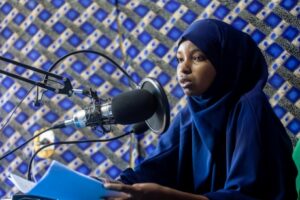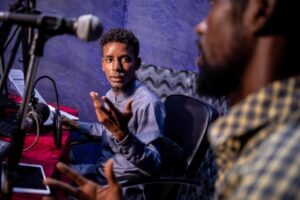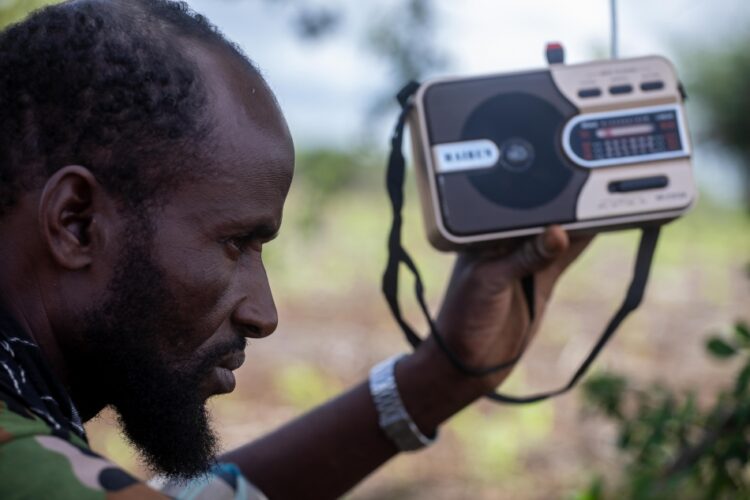How FAO is training Somali farmers through the ether
It’s been nearly 130 years since Italian inventor Guglielmo Marconi generated the first radio transmission on the Isle of Wight off the coast of England. And yet, despite the amazing digital innovations that have revolutionized global communications since that historic broadcast, radio continues to be one of the most popular forms of media in the world.
This is certainly the case in Somalia, where the Food and Agriculture Organization of the United Nations (FAO) is using this trusted medium to help farmers increase production and deal with the extreme weather conditions – from droughts to erratic rain and floods – that regularly affect this arid and semi-arid eastern African country.
Launched at the height of the COVID-19 crisis as a way of dealing with the restrictions imposed during the pandemic, FAO’s radio training modules cover a broad range of topics, such as good agricultural practices, value chain development, climate-smart agriculture, nutrition, fishery, livestock and financial education.
The use of such technology is suited for Somalia, a country with a rich oral tradition but poor internet penetration rates, especially in rural areas.
Radio is the most important and effective communication channel and the most popular type of mass media here. There are more than 60 radio stations in this sprawling country. It is also considered a credible and trustworthy source of information, as listeners can interact first-hand with this medium through call-ins or even in-person visits to the broadcasting station.
There’s also a gender element at play: most households own a portable radio, which typically requires just a couple of batteries to operate. Smartphones, by contrast, are less widespread and are generally owned by men, though the online media landscape is rapidly changing and offering new opportunities for disseminating information. At the moment, however, radio still represents the fundamental communication channel in the country. FAO on air
FAO on air
Since 2021, FAO has produced and broadcast an average of 736 episodes per year, corresponding to approximatively 14 700 minutes on air. Each episode lasts about 20 minutes and is drafted by FAO experts in English using simple, everyday vocabulary.
The episodes are then translated into the two main spoken languages in Somalia, Maaxa Tiri and Maay, and are then broadcast by 21 radio stations spread across the country, including the Public Service Broadcaster in Somaliland.
An episode focusing on water management within the context of FAO’s Climate Smart Agriculture tells farmers how best to water their crops and how to harvest rainwater that can be used during the dry season. This efficient water use approach combined with careful crop selection can help offset the impact of a changing climate.
Another episode explains to farmers how to add value to their crops by packaging produce into containers and in particular quantities in readiness for storage and transportation; and labelling the produce to allow easy identification in stores and markets.

Positive impact
In 2022, FAO carried out a detailed impact assessment to discern the effectiveness of its radio-based distance learning programme for rural communities in Somalia.
The assessment was carried out using face-to-face interviews with a random sample of 1 185 radio listeners – mostly farmers and pastoralists spread across 12 regions. It found overwhelmingly positive responses.
For instance, 94 percent of listeners said they had gained skills in crop production and better management of crop enterprises, while 64 percent of those who followed the nutrition training modules said they had applied the knowledge gained. Across the various modules, over 70 percent of those surveyed had applied the knowledge or shared it with others.
“The people in the station suggested things that we all benefited from. They said using well-selected traditional seeds can be good, and I think that is true, so I followed the advice,” states one listener named Jowhar.
Another listener of one partner station, Warsan Radio, said they had gained unexpected knowledge on “ways to fight pests using available resources.”
Respondents were particularly appreciative of the broadcasts’ question-and-answer sessions, which they said had boosted their confidence and motivation to apply and share the knowledge gained.
Perhaps most importantly, the majority of listeners said their crop productivity had increased, produce quality had improved and post-harvest losses decreased, amounting to increased incomes as a result of the training.
FAO Representative in Somalia, Etienne Peterschmitt, comments that radio programmes are part of FAO’s capacity development strategy in the country. “Through radio, we managed to overcome access challenges posed by COVID-19 restrictions and carried out remote extension to address the threats caused by climate change,” observes Peterscmitt.
Radio is the future
As the United Nations marks World Radio Day on February 13, FAO is aiming to expand and regularize these radio programmes so that listeners can learn to rely on this continuous, familiar and trustworthy information. The hope is that ministries and agricultural extension services will also fully embrace the value of radio programming for promoting rural communication services and will institutionalize this type of communication.

